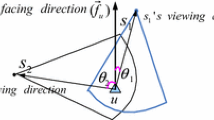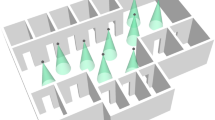Abstract
A camera sensor network is a sensor network of a group of camera sensors and is being deployed for various surveillance and monitoring applications. In this paper, we propose a new surveillance model for camera sensor network, namely half-view model, which requires a camera sensor network to capture the face image of any object if it moves forward to pass over an area of interest. Based on this new surveillance model, we introduce a new sleep-wakeup scheduling problem in camera sensor network, namely the maximum lifetime half-view barrier-coverage (MaxL-HV-BC) problem, whose goal is to find an on-off schedule of battery-operated camera sensors such that the continuous time duration providing half-view barrier-coverage over an area of interest is maximized. We develop a strategy to check if a region is half-view covered by a given set of camera sensors, and use this strategy to design two new heuristic algorithms for MaxL-HV-BC. We also conduct simulations to compare the average performance of the proposed algorithms with a trivial solution as well as the theoretical upper bound.












Similar content being viewed by others
References
Ma, H., Yang, M., Li, D., Hong, Y., & Chen, W. (2012). Minimum camera barrier coverage in wireless camera sensor networks. In Proceedings of the 31th IEEE international conference on computer communications (INFOCOM), 2012.
Huang, C., & Tseng, Y. (2003). The coverage problem in a wireless sensor network. In Proceedingso. of ACM international workshop on wireless sensor networks and applications (WSNA), 2003.
Zhang, H., & Hou, J. (2004). On deriving the upper bound of \(\alpha \)-lifetime for large sensor networks. In Proceedings of The 5th ACM international symposium on mobile ad-hoc networking and computing (MobiHoc), 2004.
Cardei, M., Thai, M., Li, Y., & Wu, W. (2005). Energy-efficient target coverage in wireless sensor networks, IEEE annual international conference on computer communications (INFOCOM), Mar. 2005, Miami, USA.
Thai, M. T., Li, Y., Wang, F., & Du, D.-Z. (2007) O(\(\log {n}\))-localized algorithms on the coverage problem in heterogeneous sensor networks. In Proceedigns of the 26th IEEE international performance computing and communications conference (IPCCC), 2007.
Kumar, S., Lai, T. H., & Arora, A. (2005). Barrier coverage with wireless sensors. In Proceedings of the 11th annual international conference on mobile computing and networking (MobiCom), 2005.
Saipulla, A., Westphal, C., Liu, B., & Wang, J. (2009) Barrier coverage of line-based deployed wireless sensor networks. In Proceedings of the 28th IEEE conference on computer communications (INFOCOM), April, 2009.
Kumar, S., Lai, T. H., Posner, M. E., & Sinha, P. (2010). Maximizing the lifetime of a barrier of wireless sensors. IEEE Transactions on Mobile Computing (TMC), 9(8), August 2010.
Yang, H., Li, D., Zhu, Q., Chen, W., & Hong, Y. (2010). Minimum energy cost \(k\)-barrier coverage in wireless sensor networks. In Proceedings of the 5th international conference on wireless algorithms, systems, and applications (WASA), 2010.
Ma, H., & Liu, Y. (2005). On coverage problems of directional sensor networks. In Proceedings of the first international conference on mobile ad-hoc and sensor networks (MSN), pp. 721–731.
Blanz, V., Grother, P., Phillips, P. J., & Vetter, T. (2005). Face recognition based on frontal views generated from non-frontal images. In Proceedings of the IEEE computer society conference on computer vision and pattern recognition (CVPR), 2005.
Liu, L., Ma, H.-D., & Zhang, X. (2008). On directional \(k\)-coverage analysis of randomly deployed camera sensor networks. In Proceedings of IEEE international conference on communications (ICC), 2008.
Wang, Y., & Cao, G.-H. (2011). On full-view coverage in camera sensor networks. In Proceedings of the 30th IEEE international conference on computer communications (INFOCOM), 2011.
Cardei, M., & Wu, J. (2006). Energy-efficient coverage problems in wireless ad-hoc sensor networks Computer Communications, 29(4), 413–420.
Chen, A., Li, Z., Lai, T. H., & Liu, C. (2011). One-way barrier coverage with wireless sensors. In Proceedings of IEEE INFOCOM, 2011.
Gage, D. (1992) Command control for many-robot systems. In Proceedings of the 19th annual AUVS technical symposium (AUVS-92), 1992.
Wang, Y., & Cao, G. (2011). Barrier coverage in camera sensor networks. In Proceedings of the ACM MobiHoc, 2011.
West, D. B. (2004). Introduction to graph theory. Illinois: Urbana.
Devarajan, D., Ranke, R. J., & Chung, H. (2006). Distributed metric calibration of ad-Hoc camera networks. In Proceedings of the ACM transactions on sensor networks.
Yang, G., & Qiao, D. (2009). Barrier information coverage with wireless sensors. In Proceedings of IEEE INFOCOM, 2009.
Kumar, S., Lai, T. H., & Arora, A. (2005). Barrier coverage with wireless sensors. In Proceedings of the ACM MobiCom, 2005.
Saipulla, A., Westphal, C., Liu, B., & Wang, J. (2009) Barrier coverage of line-based deployed wireless sensor networks. In Proceedings of IEEE INFOCOM, 2009.
Yang, G., & Qiao, D. (2010). Multi-round sensor deployment for guaranteed barrier coverage. In Proceedings of IEEE INFOCOM, 2010.
Liu, B., Dousse, O., Wang, J., & Saipulla, A. (2008). Strong barrier coverage of wireless sensor networks. In Proceedings of the ACM MobiHoc, 2008.
Saipulla, A., Liu, B., Xing, G., Fu, X., & Wang, J. (2010). Barrier coverage with sensors of limited mobility. In Proceedings of the ACM Mobihoc, 2010.
Chen, A., Kumar, S., & Lai, T. H. (2007) Designing localized algorithms for barrier coverage. In Proceedings of the ACM Mobicom, 2007.
Chen, A., Lai, T. H., & Xuan, D. (2008). Measuring and guaranteeing quality of barrier-coverage in wireless sensor networks. In Proceedins of the ACM MobiHoc, 2008.
Liu, L., Zhang, X., & Ma, H. (2009). Dynamic node collaboration for mobile target tracking in wireless camera sensor networks. In Proceedings of IEEE INFOCOM, 2009.
Shih, K. P., Chou, C. M., Liu, I. H., & Li, C. C. (2010). On barrier coverage in wireless camera sensor networks. In Proceedings of IEEE AINA, 2010.
Ford, L. R., & Fulkerson, D. R. (1954). Maximal flow through a network. Canadian Journal of Mathematics, 8, 399–404.
Kim, D., Kim, J., Li, D., Kwon, S.-S., & Tokuta, A. O. (2012). On Sleep-wakeup scheduling of non-penetrable barrier-coverage of wireless sensors. In Proceedings of the IEEE global communications conference (GLOBECOM 2012), December 2012.
Acknowledgments
This paper was jointly supported by National Natural Science Foundation of China under Grant 91124001, the Fundamental Research Funds for the Central Universities, and the Research Funds of Renmin University of China 10XNJ032. This work was also supported in part by US National Science Foundation (NSF) CREST No. HRD-1345219.
Author information
Authors and Affiliations
Corresponding author
Rights and permissions
About this article
Cite this article
Yang, M., Kim, D., Li, D. et al. Maximum lifetime suspect monitoring on the street with battery-powered camera sensors. Wireless Netw 21, 1093–1107 (2015). https://doi.org/10.1007/s11276-014-0838-3
Published:
Issue Date:
DOI: https://doi.org/10.1007/s11276-014-0838-3




